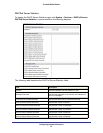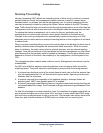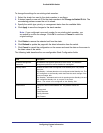
Configuring System Information
68
ProSafe M5300 Switch
Stacking
A stackable switch is a switch that is fully functional operating as a stand-alone unit but can
also be set-up to operate together with up to seven other switches. This group of switches
shows the characteristics of a single switch while having the port capacity of the sum of the
combined switches.
From the Stacking link under the System tab, you can access the following pages:
• Stack Configuration on page 72
• Stack Port Configuration on page 74
• Stack Port Diagnostics on page 76
• Stack Firmware Synchronization on page 77
One of the switches in the stack controls the operation of the stack. This switch is called the
stack master. The remaining switches in the stack are stack members. The stack members
use stacking technology to behave and work together as a unified system. Layer 2 and higher
protocols present the entire switch stack as a single entity to the network.
The stack master is the single point of stack-wide management. From the stack master, you
configure the following:
• System-level (global) features that apply to all stack members
• Interface-level features for all interfaces on any stack member
A switch stack is identified in the network by its network IP address. The network IP address
is assigned according to the MAC address of the stack master. Every stack member is
uniquely identified by its own stack member number, which is from 1–6. The stack master can
be any number within that range.
Stack Features
Stacking on the ProSafe M5300 switches supports the following:
• Up to eight switches per stack, which can be any combination of the following switch
models:
• M5300 Series (all models)
• GSM7328S
• GSM7352S
• GSM7328FS
• GSM7328Sv2
• GSM7352Sv2
• GSM7228PS
• GSM7252PS.


















